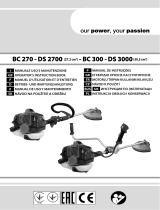
3
GB
that supplied by the manufacturer.
15 - Do not use a machine that has been
damaged, badly repaired, improperly
assembled or modified. Do not attempt to
remove or bypass any of the safety devices.
Only use cutting attachments indicated in
the table.
16 - All labels with health hazards must be kept
in good conditions. In case of damage or
deterioration, immediately substitute them
(Fig. 21).
17 - Do not utilize the machine for uses
different from the ones specified in the
manual (see pag. 8).
18 - Never leave the machine unattended with
the engine running.
19 - Do not start the engine with the arm not
mounted.
20 - Check the brush cutter daily to be sure that
components and safety devices are full
functioning properly.
21 - Do not attempt to carry out operations
or repairs that are not part of the normal
maintenance. See the authorised dealer.
22 - When disposing of the machine at the
end of its useful life, think of the
environment. Take your old unit to your
dealer who will be able to dispose of it in
a proper manner.
23 - Only experienced persons who are
familiar with the operation and safe use of
this machine should use it. If you lend the
blower to someone, also give them the
instruction manual and ensure that they
read it before using the machine.
24 - All saw service, other than the operations
shown in the present manual, should be
performed by competent personnel.
25 - Keep this manual on hand and consult it
before each use of the tool.
26 - Please note that the owner or the user is
responsible for any accidents or damage to
third parties or their property.
WARNING
- Never use a machine with faulty safety
equipment. The machine’s safety
equipment must be checked and
low intensity. This field could interfere
with certain pacemakers. To reduce the
risk of serious or fatal injury, persons with
pacemakers should consult their doctor or
the manufacturer of the pacemaker
before using this machine.
WARNING: National regulations may limit
the use of the machine.
1 - Do not operate the machine unless you
have received specific instruction on its use.
First time users must familiarise themselves
thoroughly with the operation of the
machine before working in the field.
2 - The machine must only be used by adults
in good physical condition who are familiar
with the operating instructions.
3 - Never use the brush cutter when you are
tired or fatigued or if you have taken alcohol,
drugs or medication.
4 - Wear appropriate clothing and safety articles
such as: boots, heavy-duty trousers, gloves,
protective eyewear, ear protection and
protective helmet. Use clothing which is
close-fitting but comfortable.
5 - Do not allow children to use the brush cutter.
6 - Do not allow other people to remain within
15 metres during brush cutter use .
7 - Before using the brush cutter, make sure
that the blade fixing bolt is well-tightened.
8 - The brush cutter must be equipped with
the cutting accessories recommended by
the manufacturer (look pag. 16).
9 - Never use the brush cutter without the blade
guard or the head.
10 - Before starting the engine, make sure that
the blade is free to move and is not in contact
with any foreign objects.
11 - Every now and then while working, stop
the engine and check the blade. Replace it
at the first sign of cracks or breaks.
12 - Only use the machine in well-ventilated
places, do not use in explosive or flammable
atmospheres or in closed environments.
13 - Never touch the blade or attempt any
maintenance work while the engine is
running.
14 - It is prohibited to fit any device other than
























